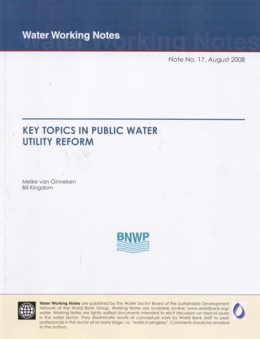|
 Urban water supply services have traditionally been provided by state-owned water utilities. In the past decades, many governments have tried to turn state-owned water utilities into effective and viable organizations – with mixed success. Why have some public utilities become more efficient service providers, while others have not been able to break the vicious cycle of low performance and low cost recovery. This report presents a framework of attributes of well-functioning utilities and how they choose and apply public utility reform approaches. Contents: Executive Summary 1. Introduction 2. Changing Realities But The Same Old Challenges 3. Attributes of A Well-Functioning Utility and Its Environment 4. Corporatization 5. The Use of Performance Agreements 6. Consumer Accountability Tools 7. Capacity Building 8. The Process of Improving and Institutionalizing Performance 9. Conclusion: Opportunitiesfor Scaling Up Public Water Utilities Reform Annex 1: Overview of Recent and Ongoing World Bank Knowledge Work on Urban Utility Reform Post Date : 01 Juli 2009 |